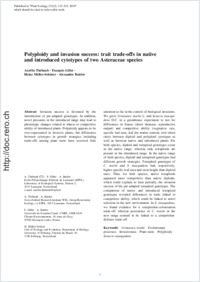Polyploidy and invasion success: trait trade-offs in native and introduced cytotypes of two Asteraceae species
- Thébault, Aurélie Ecole Polytechnique Fédérale de Lausanne EPFL, Laboratory of Ecological Systems, Lausanne, Switzerland - Swiss Federal Research Institute WSL, Group Restoration Ecology, co EPFL, Lausanne, Switzerland
- Gillet, François Ecole Polytechnique Fédérale de Lausanne EPFL, Laboratory of Ecological Systems, Lausanne, Switzerland - Université de Franche-Comté, CNRS, UMR 6249 Chrono-Environnement, Besançon, France
- Müller-Schärer, Heinz Unit of Ecology and Evolution, Department of Biology, University of Fribourg, Switzerland
- Buttler, Alexandre Ecole Polytechnique Fédérale de Lausanne EPFL, Laboratory of Ecological Systems, Lausanne, Switzerland - Swiss Federal Research Institute WSL, Group Restoration Ecology, co EPFL, Lausanne, Switzerland - Université de Franche-Comté, CNRS, UMR 6249 Chrono-Environnement, Besançon, France
-
04.08.2010
Published in:
- Plant Ecology. - 2010, vol. 212, no. 2, p. 315-325
English
Invasion success is favoured by the introduction of pre-adapted genotypes. In addition, novel pressures in the introduced range may lead to phenotypic changes related to fitness or competitive ability of introduced plants. Polyploidy appears to be over-represented in invasive plants, but differences between cytotypes in growth strategies including trade-offs among plant traits have received little attention so far in the context of biological invasions. We grew Centaurea stoebe L. and Senecio inaequidens D.C. in a greenhouse experiment to test for differences in fitness (shoot biomass, reproductive output) and competitive ability (vegetative size, specific leaf area, leaf dry matter content, root–shoot ratio) between diploid and polyploid cytotypes as well as between native and introduced plants. For both species, diploid and tetraploid genotypes occur in the native range, whereas only tetraploids are present in the introduced range. In the native range of both species, diploid and tetraploid genotypes had different growth strategies. Tetraploid genotypes of C. stoebe and S. inaequidens had, respectively, higher specific leaf area and stem height than diploid ones. Thus, for both species, native tetraploids appeared more competitive than native diploids, which could explain, at least partially, the invasion success of the pre-adapted tetraploid genotypes. The comparison of native and introduced tetraploid genotypes revealed differences in traits linked to competitive ability, which could be linked to novel selection in the new environment. In S. inaequidens, we found evidence for a competition-colonisation trade-off, whereas persistence of C. stoebe in the new range seemed to be linked to a competition-defence trade-off.
- Faculty
- Faculté des sciences et de médecine
- Department
- Département de Biologie
- Language
-
- English
- Classification
- Ecology and biodeversity
- License
-
License undefined
- Identifiers
-
- RERO DOC 23208
- DOI 10.1007/s11258-010-9824-8
- Persistent URL
- https://folia.unifr.ch/unifr/documents/301884
Other files
Statistics
Document views: 113
File downloads:
- pdf: 194
- Supplementary material: 169

